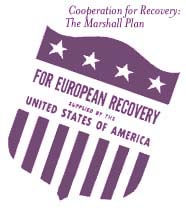Money
Matters: An IMF Exhibit -- The Importance of Global Cooperation
|
Destruction
and Reconstruction (1945-1958)
|
Part
4 of 6
|
|
|
|
| |
Cooperation
for Recovery: The Marshall Plan
|
| <--Previous
|
Next--> |
| |
Dollar
Catalyst
|
|
In
his historic speech at Harvard’s graduation ceremony in June
1947, George Marshall announced the U.S. plan to give additional
economic aid to Europe. The offer was made to all of Europe, including
the U.S. wartime enemies and the Communist countries of Eastern
Europe. However, the recipients would be required to work together
to formulate a unified recovery plan.
|
 credits
credits |
The
European Response
|
|
"When
the Marshall Plan proposals were announced, I grabbed them with
both hands. I felt that it was the first chance we had ever been
given since the end of the war to look at [the] European economy
as a whole."
Ernest
Bevin
British Foreign Secretary
Sixteen European countries responded by cooperating on a general
reconstruction plan that was accepted by the United States. In the
end, a total of $13.6 billion (equivalent to $88 billion in 1997
money) was appropriated to the plan. The Marshall Plan was a success.
By 1950, the participating countries had returned to, or exceeded,
their prewar production levels.
|
The
European Recovery Program (ERP - The Marshall Plan) helped Europe
to:
|
- Finance
its imports and debts without the burden of future repayment
- Replace,
rebuild and expand both private industry and public infrastructure
- Eliminate
bottlenecks in production
- Restore
consumption to a politically acceptable level
- Establish
and fund the European Payments Union to promote multilateral,
rather than bilateral, trade
- Eliminate
the worldwide dollar shortage
|
Conditionality
|
|
Marshall
aid came with "conditionality" - countries wishing to
participate had to agree to:
- Develop
multilateral payment and trade within Europe
- Move
toward currency convertibility
- Move
toward eliminating discrimination against U.S. imports
- Encourage
reductions in public spending
- Relax
government controls such as rationing
- Increase
exports to the United States
|
| |
|
| <--Previous
|
Next--> |